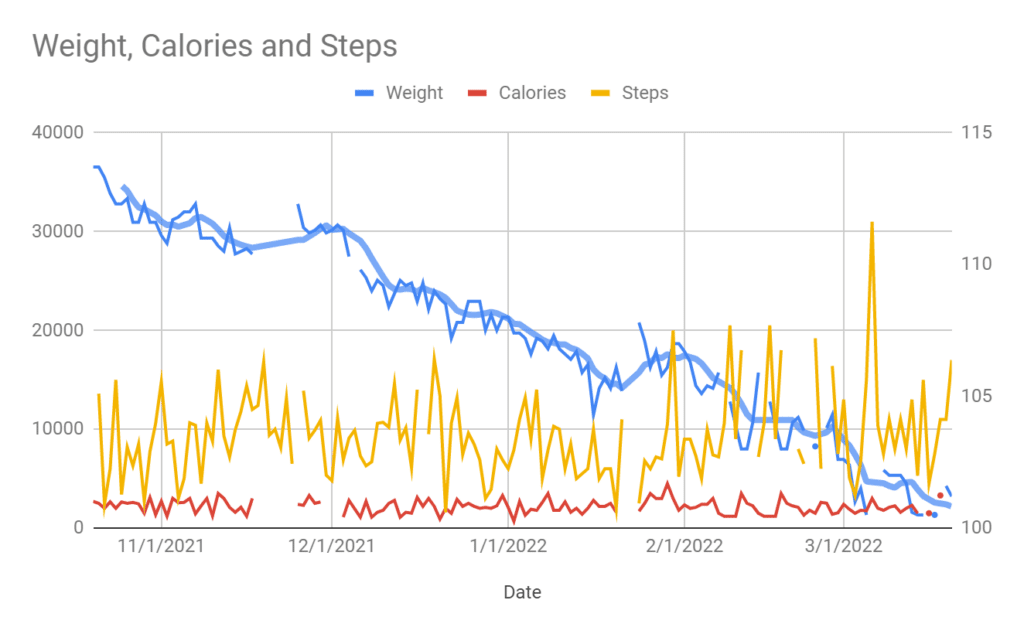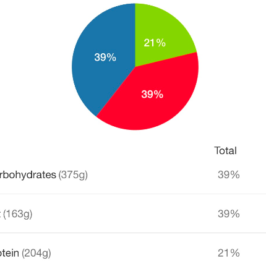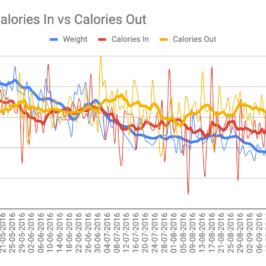- How Much Weight Can You Realistically Lose in 3 Months? - January 14, 2024
- How To Lose 1kg a Week (Guaranteed) - August 20, 2023
- How To Count Calories (or Estimate) and Stay on Track When Eating Out at Restaurants - July 25, 2023
To lose weight, you HAVE to create a calorie deficit (burn more calories than you eat) over a period of time. There’s no two ways about it.
This is true whether you chose to count calories or not.
While calorie counting offers, in my opinion, the most efficient method for ensuring you’re sticking to a deficit, you don’t need to do it to lose weight.
There are plenty of excuses people come up with for not counting calories, including;
- It’s too time-consuming (it’s not, once you’ve done it for a couple of weeks, it can take a couple of minutes each day to log your food)
2. It’s not accurate (When it comes to measuring calories in, calories out, weight and body fat NOTHING is 100% accurate – what matters are the trends over time, not the actual numbers).
3. I Don’t Know How to Use MyFitness Pal (learn it. If you can use Facebook and Instagram you can use MFP).
If any of these are your rationalization for not counting calories, then maybe losing weight isn’t high enough on your list of priorities.
If you have another reason for not wanting to count calories (and ‘not wanting to’ is a perfectly valid one), then there are some tactics you can employ to make it more likely that you’ll be in a caloric surplus.
Here are some of my favourites;
1. EAT LESS CALORIE-DENSE FOODS/INCREASE FOOD VOLUME
One of the things that will make you feel full, is how much total volume of food is in your stomach.
In really simplistic terms, 200g of food (whatever that food is) will make you feel fuller than 100g of food, regardless of the calorie content.
This means that, if you can eat 200g of food containing 300 calories, it’s going to be better than 100g of food containing 300 calories, because it will keep you fuller for longer.
A really simple example of how you could implement this would be swapping out red meat for white meat.
Let’s say you have you a 150g Ribeye Steak for dinner every Friday, and you swap that out for 300g of Chicken Breast.
Boom, you’ve saved yourself almost 100 calories, plus you’re going to feel a lot fuller for a lot longer (simply because there’s more food in your gut) just by making a simple swap.
Chances are, there are probably numerous opportunities to make these kinds of swaps, which will mean you can easily eliminate hundreds of calories per day while staying just as full, if not fuller
| Item | Weight | Calories | Calories per g |
| Ribeye Steak | 150g | 436 | 3 |
| Chicken Breast | 300g | 330 | 1 |
Another great example is swapping out regular soft drinks for the diet versions; a regular 330ml can of coke comes in at 140 calories, while Diet Coke is as good as 2 calories; both are exactly the same volume of liquid, both are equally as filling.
This means you could have 2 Diet Cokes at 660ml for 4 calories and feel a lot fuller than if you’d had one regular can.
I’ve written more extensively about low calorie dense foods here.
2. DECREASE PORTION SIZES
This one is so easy and so obvious I can barely believe I’m writing about it, but here goes.
Carry on eating all the foods you’re eating right now, and the same number of meals, just eat less.
Easy.
Let’s continue with the steak example.
If you reduce that 150g Ribeye Steak to 100g, you save 145 calories, nothing to be sniffed at.
The beauty of this method is that you can carry on eating exactly the same as you are now, you just eat less of it.
If you don’t want to weigh your food, it’s not absolutely necessary, just eyeball it.
If you eat a lot of pre-packed food, that makes this method even easier, just reduce the amount of packs you’re eating – if you have two packets of crisps for an afternoon snack, have one instead.

3. CHOOSE LOW-FAT OPTIONS
Low-fat alternatives to popular foods have been absolutely slammed in the media over the years.
Many (rightly) recognised that some reduced-fat versions of foods had more sugar to make them taste better.
Even if this is true, guess what? It doesn’t matter.
There’s nothing wrong with sugar, and remember, we’re shooting for lower calories here, so if you can find reduced-fat versions of your favourite foods that are lower in calories, then you’re onto a win.
Fat has 9 calories per gram, whereas carbs and protein both have 4 calories per gram.
This means if a particular low fat food has 10g less fat than it’s ‘regular’ counterpart, it’ll have 90 fewer calories.
Even if it has an extra 10g of sugar, that’s only 40 calories, so we’re still making an overall saving of 50 calories.
You’ll be able to make the biggest calorie savings from the foods that are highest in fat, for example
You’ll be able to make the biggest calorie savings from the foods that are highest in fat, for example
| Item | Amount | Calories | Swap | Calorie Saving |
| Olive Oil | 100ml | 824 | Fry Light Spray Oil | 819 |
| Cheddar Cheese | 100g | 416 | Low Fat Cheese | 85 |
| Peanut Butter | 100g | 584 | Powdered PB | 140 |
4. SKIP MEALS
If you eat a 300 calorie breakfast every day, and you stop doing that, you’ve saved yourself 2,100 calories over the course of a week – that’s over half a pound of fat lost (provided everything else stays consistent) just by doing something like cutting out a meal.
A lot of people eat breakfast, lunch and dinner just because that’s what they’ve always done, rather than because they’re actually hungry at those set meal times.
If you’re not hungry at breakfast – don’t eat it.
Similarly, if you get in from work and you’re not really hungry, skip dinner, or have a snack instead.
Dinner doesn’t have to be an elaborate plate of food piled high with meat, carbs and sauces plus a side salad drizzled with gallons of olive oil, then a dessert; you could just have an omelette.
A posh term for this that many coaches will use to make themselves sound intelligent is ‘intermittent fasting’.
It’s exactly the same thing.
If you eat your last meal at 8pm on Tuesday, skip breakfast and don’t eat until 12 noon on Wednesday, you’ve intermittently fasted for 12 hours.
If this approach sounds appealing you may want to try OMAD – which is a diet where you’ll only eat once a day.

5. DON’T BUY SNACKS
When you go shopping, don’t buy non-essential high-calorie snack food.
If you don’t physically have it, you can’t eat it.
This has to be the simplest tip of the lot.
6. CREATE CALORIE BUFFERS
What I call ’calorie buffers’ are a really simple way to compensate for a massive blowout meal (or a blow out day).
Let’s you know you have a big day of eating coming up; you’re going out to a new restaurant on Saturday and you know you’re going to want 3 courses. You’re probably looking at 1200 calories with drinks in a single sitting.
Rather than just eating as you normally would in the run up, restrict your calories.
For example, you could have a really low-calorie day the day before.
If you don’t like the sound of that, what’s probably easier is having a buffer day after your blow out. This is because you’re likely to have stuffed yourself and probably won’t have a huge appetite the next day, so undereating which be much easier.
Your buffer doesn’t necessarily need to take place in its entirety the day before, you could eat a bit less on Thursday and a bit less on Friday, or a bit less on the Sunday and the Monday.
Similarly, if you know you’re going to be overeating for a long period of time; maybe you’re going to an All-In resort for a week (I know, I’m a sucker for the breakfast buffet as well), you might want to try to create a week-long buffer.
Think of your calories like your bank account – if you know you’re going to spend a lot more money than usual (read: eating a lot more) on a particular weekend, you probably wouldn’t go out at all (read: eat very much) the weekend before so you could save; this will make it less likely that you’ll go into your overdraft (read: a calorie surplus, which will lead to weight gain).
7. STOCK UP ON DIET COKE
I’ve already mentioned Diet Coke once but I genuinely believe it’s an incredibly useful tool when you’re dieting.
It tastes amazing, is filling (partly because it’s carbonated), and literally has zero calories.
If you don’t like Coke, there’s a Diet/Zero version of pretty much every soft drink you can imagine.
Squash it also a good shout.

WHAT NOT TO DO
Don’t adopt a ‘clean eating mentality.
While eating lots of ‘natural’, and ‘unprocessed’ foods (I’ve put those words in inverted commas because they don’t actually mean anything) sounds like it might help you lose weight, the reality is it comes down to creating a calorie deficit, regardless of what you eat.
While eating lots of fruit and veg is a great idea because fruit and particularly vegetables are filling and contain very few calories, there are several foods recommended by ‘clean eaters’ that could do more harm than good.
For example; oily fish and nuts both featurely highly on lists of ‘clean’ foods, and while they’re great to eat from an overall health point of view, they contain a LOT of calories.
Nuts are particularly easy to overeat so I’d avoid them
If you need any help with weight loss, don’t hesitate to get in touch.
WHAT ARE THE SIGNS THAT YOU’RE IN A CALORIE DEFICIT?
It’s pretty easy to tell that you’re in a calorie deficit, there are few different signs you can look for.
WEIGHT LOSS
Yep, it’s impossible to be in a calorie deficit and not lose weight, so if the scale weight is going down over weeks and months, you’re definitely in a deficit.
Where people go wrong with assessing this is, they only give it a week, or a few days. If you start implementing behaviours that will be more likely to get you into a deficit, you need to give it at least 3 weeks to start seeing results, AND you need to be weighing yourself on a daily basis.
Weekly weighing won’t cut it, because weight can fluctuate so much, such a low frequency of weigh-ins could mask fat loss and make you feel demotivated.
Below is one of the weight loss graphs for my clients, while the overall long-term trend (this is across 5 months) goes down, you can see just how volatile it is.

CLOTHES WILL FIT BETTER
Scales are a great, objective way to measure weight loss, but your measurements will change as well.
When we lose body fat, we lose it in equal amounts from all over our body, this means that our stomach, thighs, hips, arms, neck and face will all shrink in unison.
Having said that, you will likely notice weight loss more in certain areas than others.
Men will tend to notice weight loss more around the stomach and waistline, while women will generally see greater losses around the thighs, hips and the butt.
So, if that favourite pair of jeans from your 20s starts not feeling so snug anymore, you can be pretty that you’re in a calorie deficit and losing weight
APPETITE WILL DECREASE
As you lose weight, you become a smaller person.
And smaller people need fewer calories to stay alive and move around than larger people do.
As a result, your drive to consume as much food as you did previously will come down. Your body will also just get used to eating fewer calories.
So if you find yourself naturally wanting to eat less food, again this could be because you’re in a deficit and losing weight.
SUMMARY
You DO need to be in a calorie deficit to lose weight, but you don’t necessarily need to count calories to achieve a deficit.
If you’ve been unsuccessful at creating a deficit in the past, you will need to implement some healthy habits consistently such as;
- Doing more activity
- Eating more protein
- Getting 7-9 hours sleep per night
- Drinking more water
You will also need to be tracking your weight on a daily basis, because if you don’t, you won’t know what’s working and what’s not.







Leave a Reply